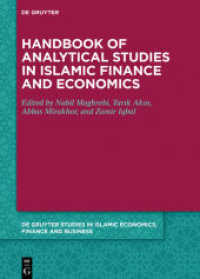- ホーム
- > 洋書
- > 英文書
- > Cinema / Film
Full Description
The history of postwar German cinema has most often been told as a story of failure, a failure paradoxically epitomized by the remarkable popularity of film throughout the late 1940s and 1950s. Through the analysis of 10 representative films, Hester Baer reassesses this period, looking in particular at how the attempt to 'dismantle the dream factory' of Nazi entertainment cinema resulted in a new cinematic language which developed as a result of the changing audience demographic. In an era when female viewers comprised 70 per cent of cinema audiences a 'women's cinema' emerged, which sought to appeal to female spectators through its genres, star choices, stories and formal conventions. In addition to analyzing the formal language and narrative content of these films, Baer uses a wide array of other sources to reconstruct the original context of their reception, including promotional and publicity materials, film programs, censorship documents, reviews and spreads in fan magazines. This book presents a new take on an essential period, which saw the rebirth of German cinema after its thorough delegitimization under the Nazi regime.
Contents
Figures
Acknowledgments
Introduction: Postwar German Cinema
Chapter 1. The Female Gaze in The Murderers Are Among Us
Chapter 2. Authorship and Stardom in Film Without a Title
Chapter 3. Love '47 as Woman's Film
Chapter 4. Race, Ethnicity, and Gender in Epilogue
Chapter 5. Regendering Representation in The Sinner
Chapter 6. Visual Pleasure and Cinematic Realism in The Forester of the Silver Wood
Chapter 7. Gender and Sexuality in Different From You and Me
Chapter 8. Spectatorship and Genre in Engagement in Zurich
Chapter 9. Critical Strategies of The Girl Rosemarie
Chapter 10. The Bread of Those Early Years as Transitional Film
Epilogue: Adapting the 1950s
Bibliography
Index







